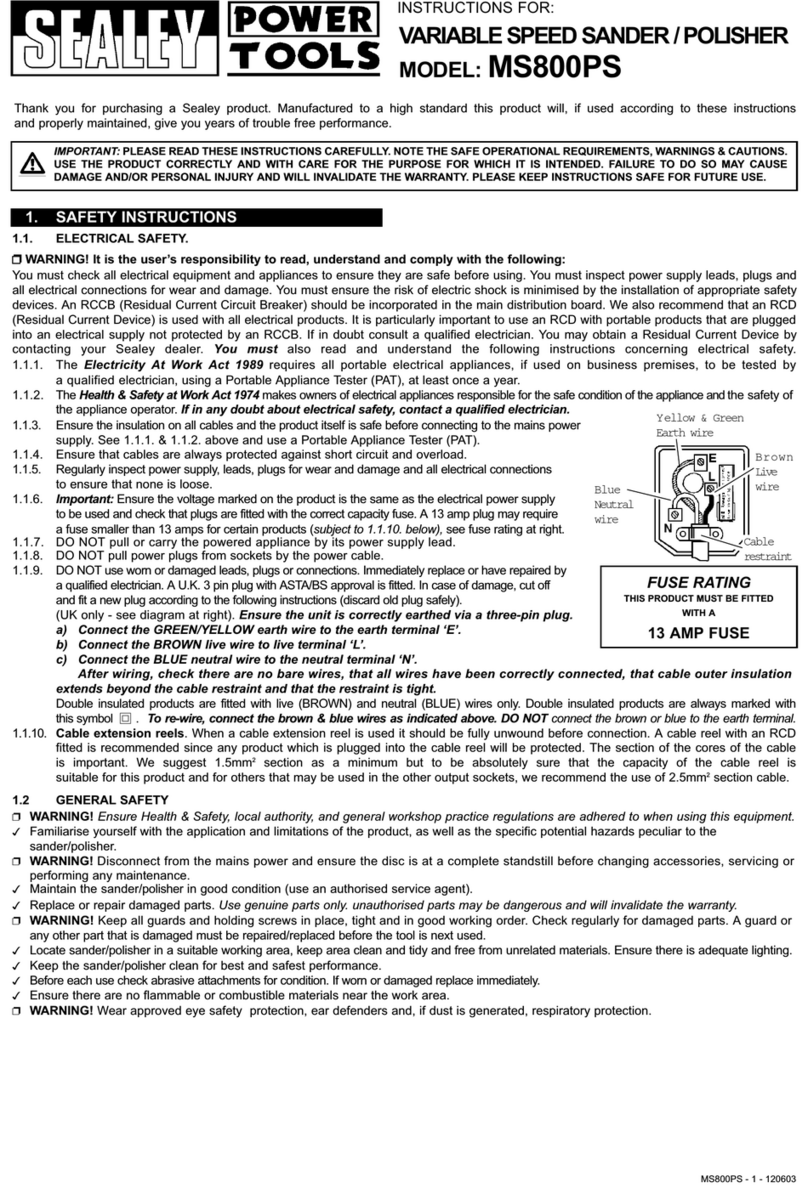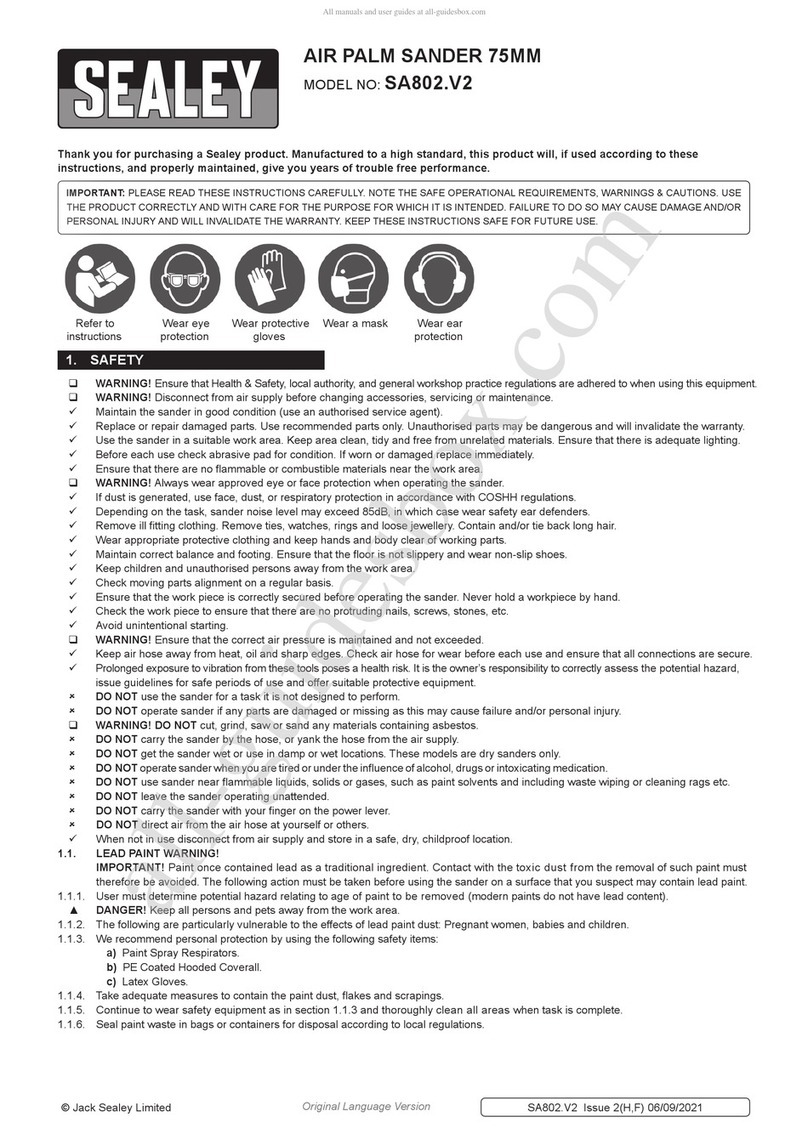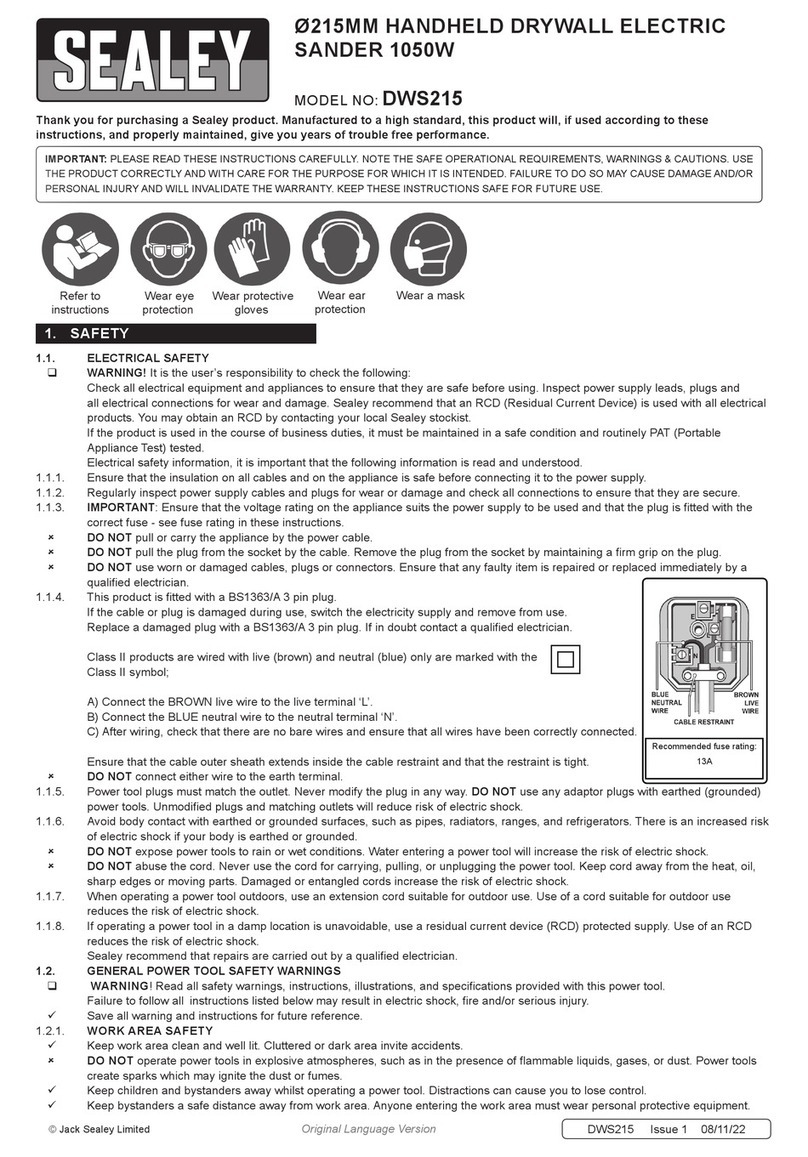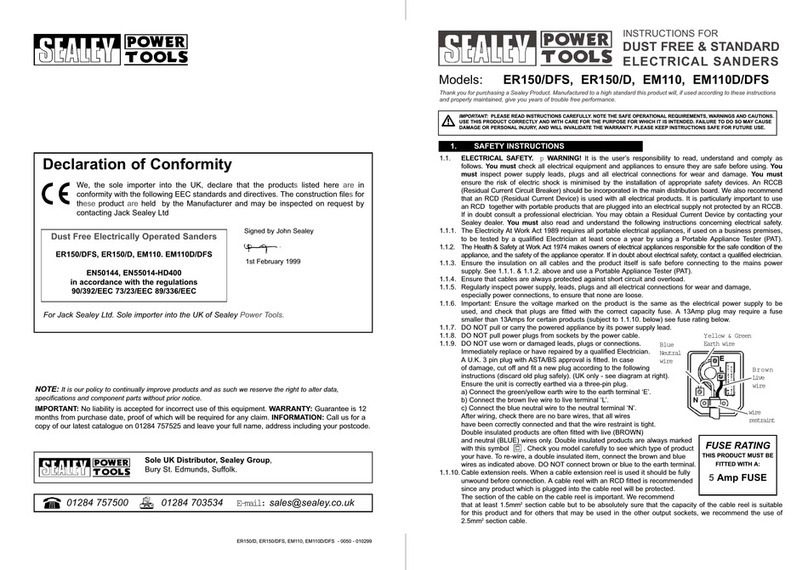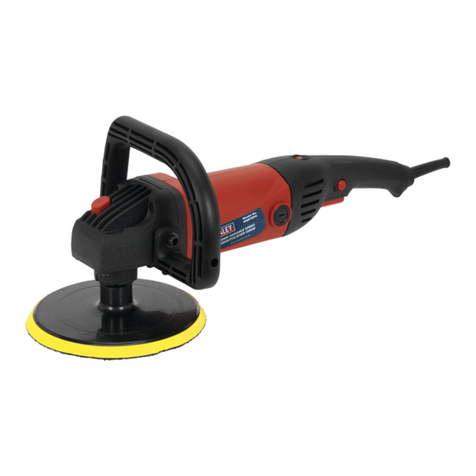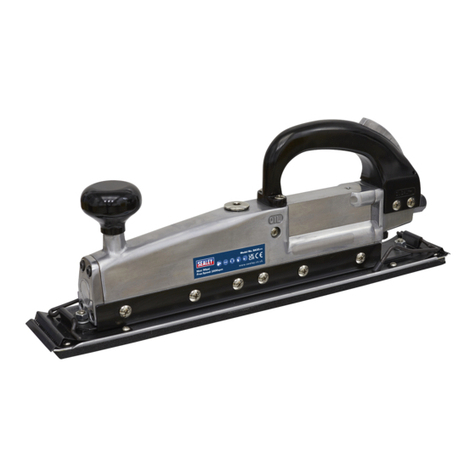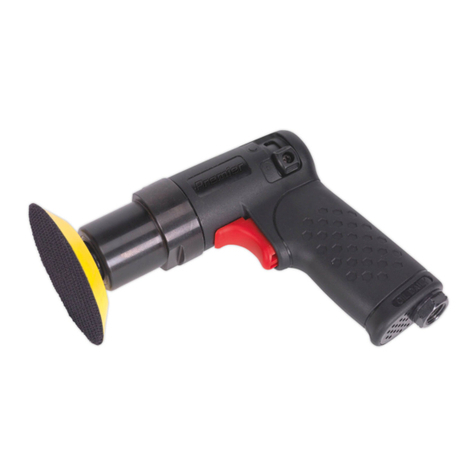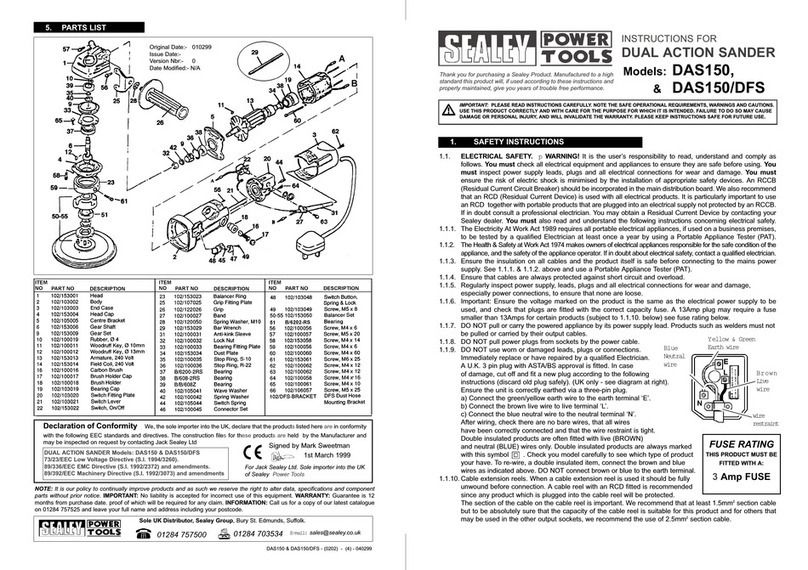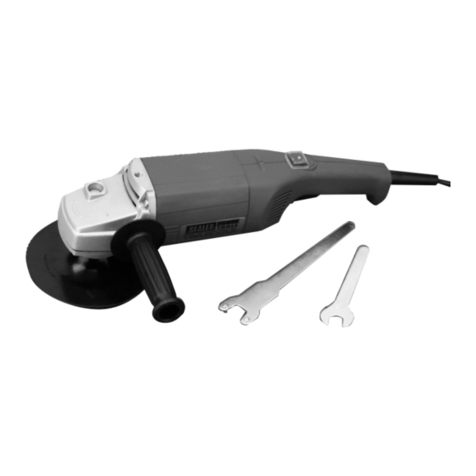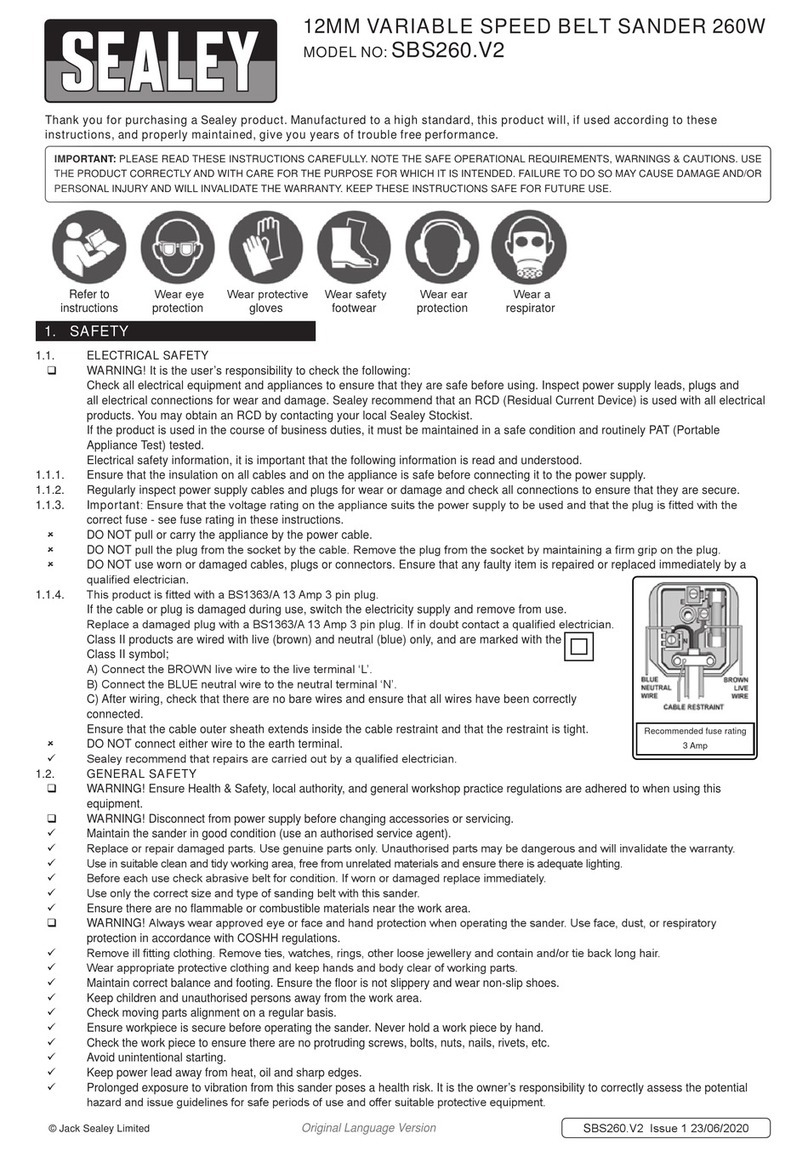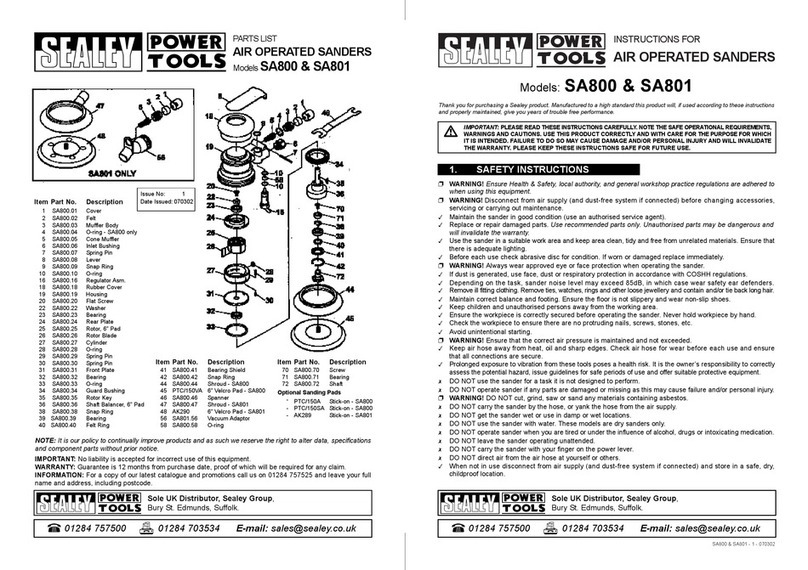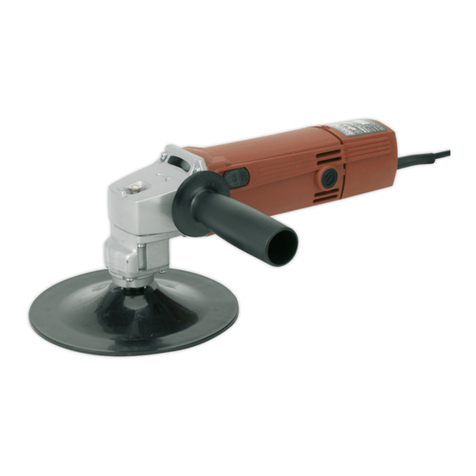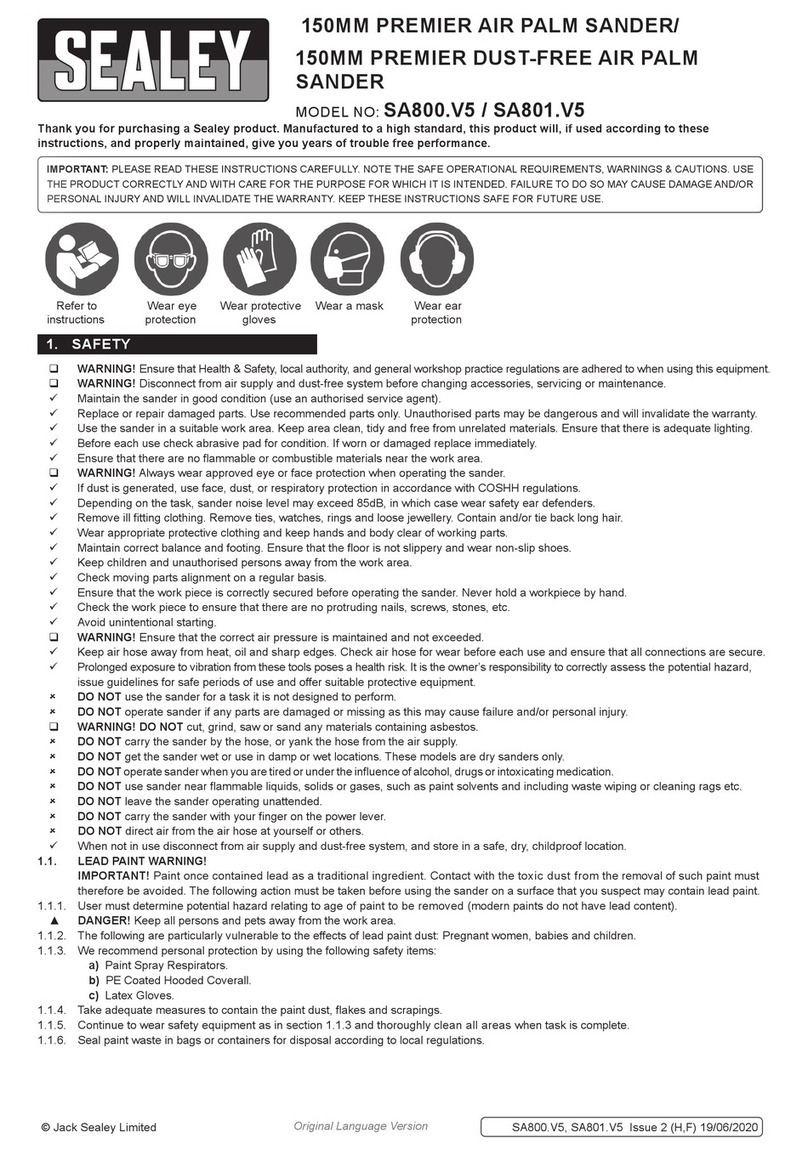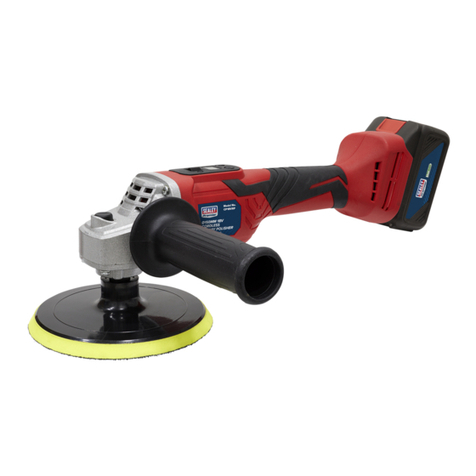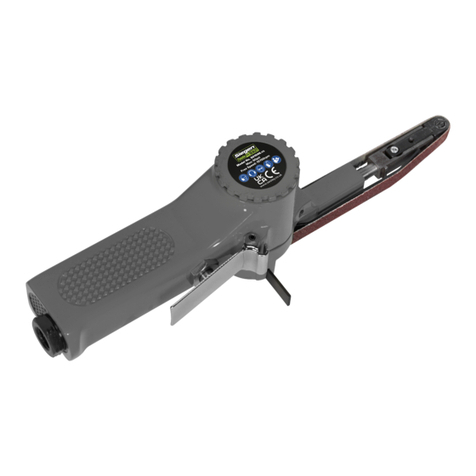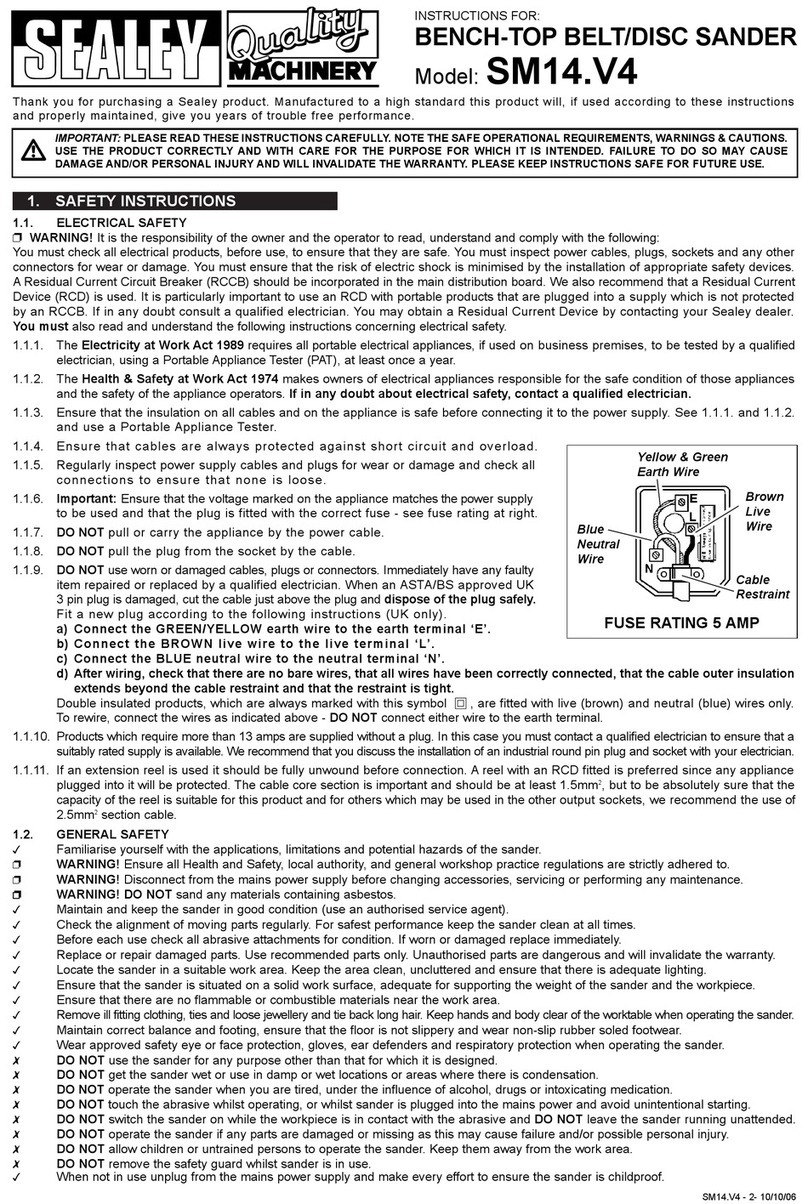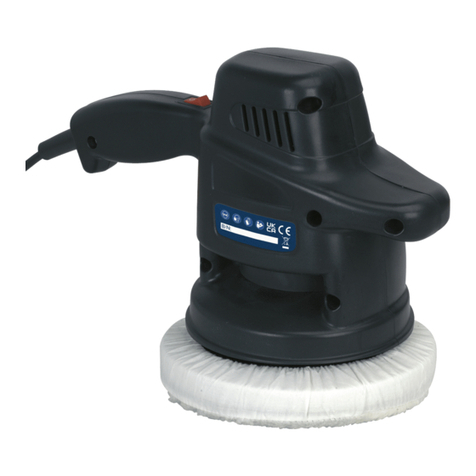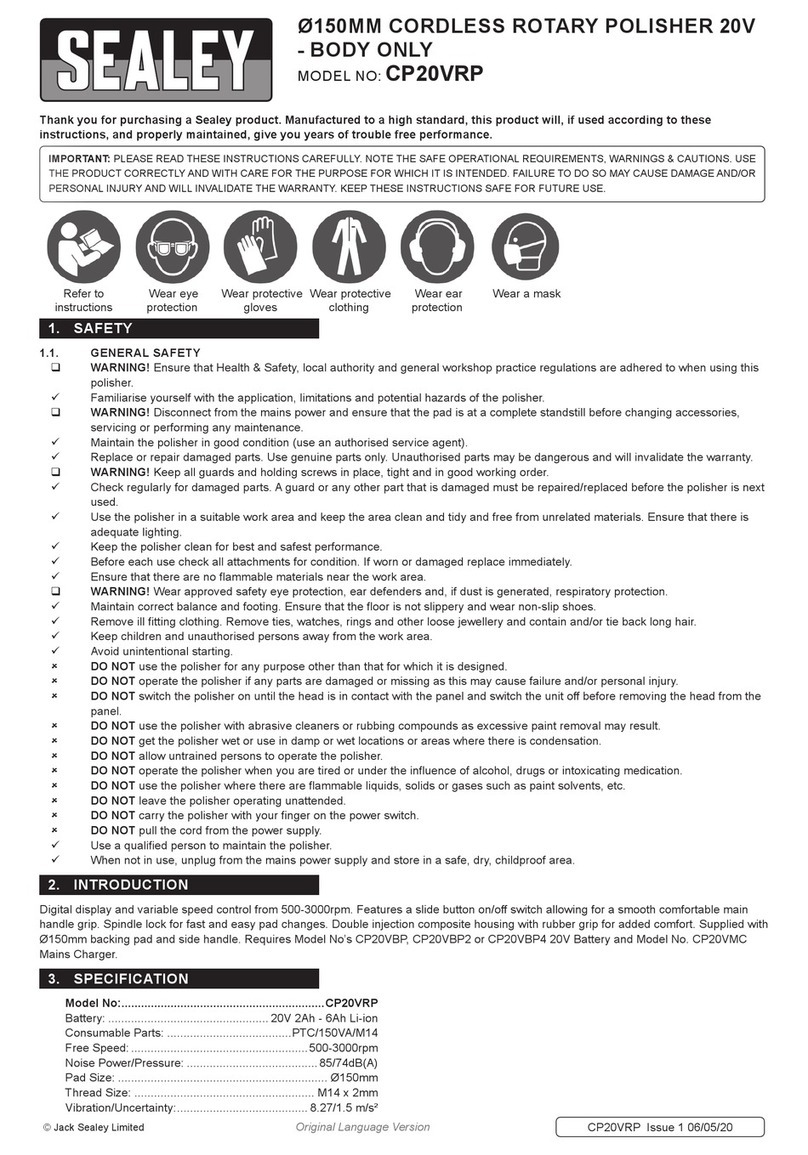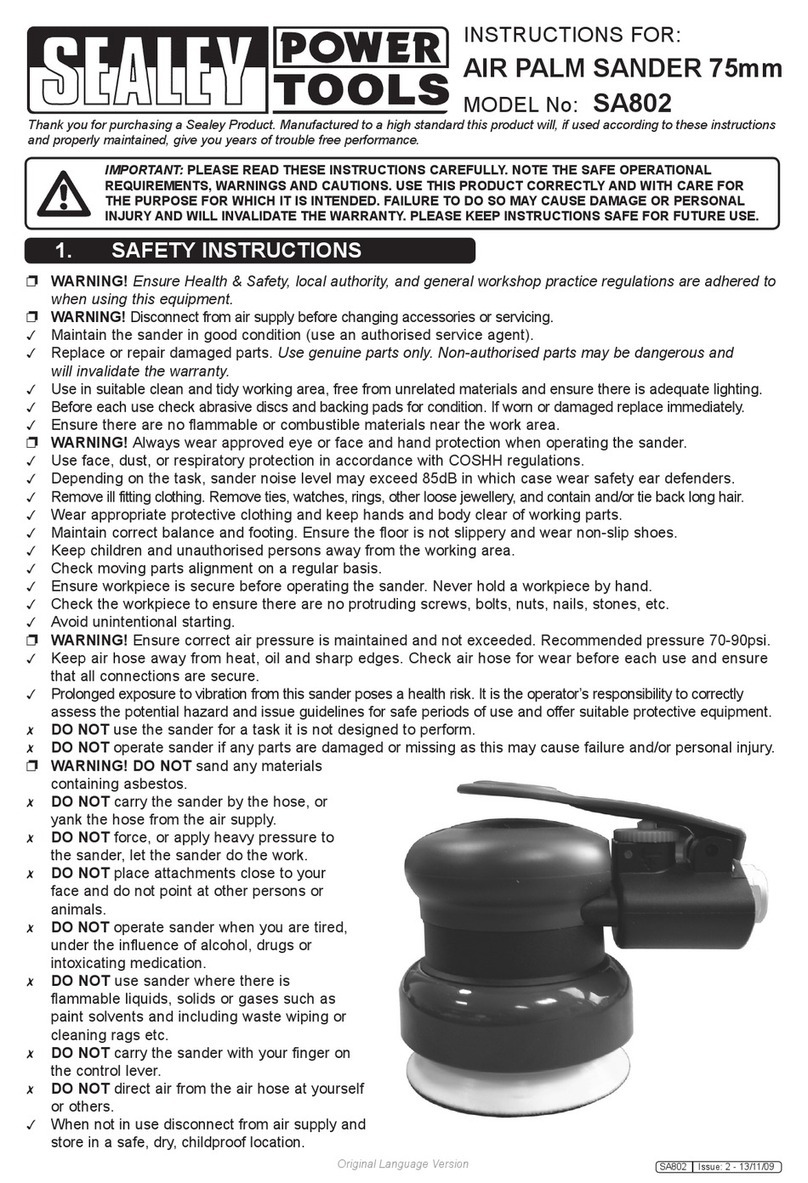
Blue
Neutral
Wire
INSTRUCTIONS FOR:
150mm RANDOM ORBITAL
VARIABLE SPEED SANDER
MODEL No: DAS151
Thank you for purchasing a Sealey product. Manufactured to a high standard this product will, if used according to these instructions and properly maintained, give you
years of trouble free performance.
IMPORTANT: PLEASE READ INSTRUCTIONS CAREFULLY. NOTE THE SAFE OPERATIONAL REQUIREMENTS, WARNINGS AND CAUTIONS. USE
THIS PRODUCT CORRECTLY AND WITH CARE FOR THE PURPOSE FOR WHICH IT IS INTENDED. FAILURE TO DO SO MAY CAUSE DAMAGE AND/
OR PERSONAL INJURY AND WILL INVALIDATE THE WARRANTY. PLEASE KEEP INSTRUCTIONS SAFE FOR FUTURE USE.
1. SAFETY INSTRUCTIONS
1.1. Electrical Safety
WARNING! It is the user’s responsibility to read, understand and comply
with the following:
You must check all electrical equipment and appliances to ensure they
are safe before using.
You must inspect power supply leads, plugs and all electrical connections
for wear and damage.
You must ensure the risk of electric shock is minimised by the installation
of appropriate safety devices. An RCCB (Residual Current Circuit Breaker)
should be incorporated in the main distribution board. We also recommend
that an RCD (Residual Current Device) is used with all electrical products.
It is particularly important to use an RCD with portable products that are
plugged into an electrical supply not protected by an RCCB. If in doubt
consult a qualified electrician. You may obtain a Residual Current Device
by contacting your Sealey dealer. You must also read and understand the
following instructions concerning electrical safety.
1.1.1. The Electricity At Work Act 1989 requires all portable electrical appliances,
if used on business premises, to be tested by a qualified electrician, using
a Portable Appliance Tester (PAT), at least once a year.
1.1.2. The Health & Safety at Work Act 1974 makes owners of electrical
appliances responsible for the safe condition of the appliance and the
safety of the appliance operator. If in doubt about electrical safety, contact
a qualified electrician.
1.1.3. Ensure the insulation on all cables and the product itself is safe before
connecting to the mains power supply. See 1.1.1. & 1.1.2. above and use
a Portable Appliance Tester (PAT).
1.1.4. Ensure that cables are always protected against short circuit and overload.
1.1.5. Regularly inspect power supply leads and plugs for wear and damage
and all electrical connections to ensure that none are loose.
1.1.6. Important: Ensure the voltage marked on the product is the same as the
electrical power supply to be used and check that plugs are fitted with the
correct capacity fuse. A 13 amp plug may require a fuse smaller than 13
amps for certain products, see fuse rating below.
1.1.7. DO NOT pull or carry the appliance by the power supply lead.
1.1.8. DO NOT pull power plugs from sockets by the power cable.
1.1.9. DO NOT use worn or damaged leads, plugs or connections. Immediately
replace or have repaired by a qualified electrician. A U.K. 3 pin plug
with ASTA/BS approval is fitted. In case of damage, cut off and fit a
new plug according to the following instructions, discard old plug safely
(UK only - see diagram at right). Ensure the unit is correctly earthed via a
three-pin plug.
a) Connect the green/yellow earth
wire to the earth terminal ‘E’.
b) Connect the brown live wire
to live terminal ‘L’.
c) Connect the blue neutral wire
to the neutral terminal ‘N’.
After wiring, check that there are no
bare cores, that all wires have been
correctly connected, that the cable
external insulation extends beyond the
cable restraint and that the restraint is
tight.
Double insulated products are fitted
with live (BROWN) and neutral
(BLUE) wires only. Double
insulated products are always marked
with this symbol . Check your model
carefully to see which type of product your have. To rewire a double
insulated item, connect the brown and blue wires as indicated above.
DO NOT connect brown or blue to the earth terminal.
1.1.10. Cable extension reels. When a cable extension reel is used it should be
fully unwound before connection. A cable reel with an RCD fitted is
recommended since any product which is plugged into the cable reel
will be protected. The section of the cores of the cable is important and
should be at least 1.5mm2, but to be absolutely sure that the capacity of
the cable reel is suitable for this product and for others that may be used
in the other output sockets, we recommend the use of 2.5mm2section
cable.
1.2. General Safety
WARNING! Ensure Health & Safety, local authority, and general work
shop practice regulations are adhered to when using this equipment.
WARNING!Disconnect from mains power before changing accessories
or servicing.
Maintain the sander in good condition (use an authorised service agent).
Replace or repair damaged parts. Use genuine parts only.
Unauthorised parts may be dangerous and will invalidate the warranty.
Yellow & Green
Earth Wire
Brown
Live
Wire
FUSE RATING
THIS PRODUCT MUST BE
FITTED WITH A
5 AMP FUSE
LEAD PAINT WARNING!
Paint once contained lead as a traditional ingredient. The dust from the
removal of such paint is toxic if inhaled or ingested and must, therefore, be
avoided. The following action must be taken before using the sander on a
surface that you suspect may have contained lead in the paint.
1. User must determine potential hazard relating to age of paint to be
removed. (Modern paints do not contain lead).
2. DANGER! Keep all persons and pets away from the work area. The
following are particularly vulnerable to the effects of lead paint dust:
Expectant women, babies and children.
3. We recommend personal protection by using the following safety items:
a) Paint Spray Respirator (Sealey ref: SSP1699)
b) PE Coated Hooded Coverall (Sealey ref: SSP266)
c) Latex Gloves (Sealey ref: SSP24)
4. Take adequate measures to contain the paint dust, flakes, and scrapings.
5. Continue to wear safety equipment as in 3 above, and thoroughly clean all
areas when task is complete. Ensure that paint waste is disposed of, in
sealed bags or containers, according to local authority regulations.
Use sander in a suitable work area. Keep area clean, tidy and free from
unrelated materials. Ensure that there is adequate lighting.
Before use, check abrasive pad condition. If worn or damaged replace
immediately.
WARNING! Always wear approved eye or face protection when operating the
sander.
If dust is generated, use face, dust, or respiratory protection in accordance
with COSHH regulations.
Depending on use, sander noise level may exceed 85dB - in which case wear
safety ear defenders.
Remove ill fitting clothing, ties, watches, rings, other loose jewellery and
contain and/or tie back long hair.
Wear appropriate protective clothing and keep hands and body clear of
moving parts.
Maintain correct balance and footing. Ensure the floor is not slippery and
wear non-slip shoes.
Keep children and unauthorised persons away from the work area.
Always use the sander with the side handle securely screwed in.
Ensure the workpiece is correctly secured before operating the sander. Never
hold workpiece by hand and check the workpiece to ensure there are no
protruding nails, screws, rivets, etc.
Avoid unintentional starting.
DO NOT use the sander for a task it is not designed to perform.
DO NOT operate sander if any parts are damaged or missing. This may cause
failure and/or injury.
WARNING! DO NOT sand any materials containing asbestos.
DO NOT carry the sander by the electrical cable.
DO NOT use sander with water, get the sander wet or use in damp or wet
locations, the sander is for dry use only.
DO NOT operate sander if you are tired or under the influence of alcohol,
drugs or intoxicating medication.
DO NOT use where there are flammable liquids, solids or gases such as
paint solvents or waste wiping or cleaning rags.
DO NOT leave the sander running unattended.
DO NOT carry the sander with your finger on the power switch.
When not in use disconnect from power supply and store in a safe, dry,
childproof area.
Original Language Version DAS151 Issue: 2 - 18/02/10
Cable
Restraint
Risk of Hand Arm Vibration Injury.
The DAS151 Random Orbital Variable Speed Sander, when operated in accor-
dance with these instructions and tested in accordance with
BS EN 28662-
1:1993, ISO 8662-1:1988 and BS EN ISO 8662-4:1995, ISO 8662-4:1994
results in the following vibration emission declared in accordance with BS
EN12096:1996.
Measured vibration emission value:
4.46
m/s
²
Uncertainty:
1.78
m/s
²
These values are suitable for comparison with emission levels of other tools
that have been subject to the same test.
This tool may cause hand-arm vibration syndrome if its use is
inadequately managed.
This is a ‘NO LOAD’ vibration figure.
A competent person should carry out a risk assessment following HSE
guidelines. Measurement results can be highly variable, depending on many
factors, including the operator's technique, the condition of the work equipment,
the material being processed and the measurement method.
Recommended Measures to reduce risk of hand-arm vibration syndrome:
We recommend appropriate safety equipment is utilised and regular breaks for
the operator are employed to reduce any residual risk of fatigue or repetitive
strain injury.
